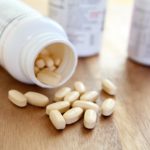While we have been talking about using brexanolone, marketed by Sage Therapeutics as Zulresso, for the treatment of postpartum depression, an oral version of this novel antidepressant – SAGE 217 or zuranolone – has been finishing up its Phase 3 trials.
Like brexanolone, SAGE-217 is a neurosteroid, an analogue of allopregnanolone which is a positive allosteric modulator of the GABA-A receptor. What distinguishes SAGE-217 from brexanolone is that it has much better oral bioavailability and thus does not have to be administered intravenously. It can be taken as an oral medication, just like conventional antidepressants.
Shortly before the end of the year, Sage Therapeutics released disappointing results for their Phase 3 MOUNTAIN study, where SAGE-217 was being used to treat adults with major depressive disorder (MDD). While this trial showed small but statistically significant differences between SAGE-217 and placebo HAM-D total score on Days 3, 8 and 12, the difference on day 15 was not statistically significant.
But wait! Post-hoc analysis revealed that in the MOUNTAIN Study, about 9% of the patients in the SAGE-217 group did not have measurable drug levels, suggesting non-compliance in a substantial number of patients taking SAGE-217. When they repeated the analysis, excluding these patients who were non-compliant, they observed a statistically significant difference at all timepoints including Day 15.
In another analysis, where they included only patients with more severe depressive symptoms (HAM-D > 24, n=124 for SAGE-217 30 mg), a post-hoc analysis demonstrated statistical significance at all timepoints through, and including Day 15.
Hopefully future studies will help to answer some of these lingering questions.
SAGE-217 Looks Different in Postpartum Depression Trials
The results of the Phase 3 trials in women with postpartum depression have clearly received less attention, but in September last year, results of the ROBIN study were presented at the 32nd European College of Neuropsychopharmacology (ECNP) Congress.
The Phase 3 ROBIN Study evaluated SAGE-217 in 151 women who were diagnosed with severe PPD (HAMD of 26 or higher). Similar to the MOUNTAIN protocol, women were randomly assigned to receive either placebo or SAGE-217 30 mg one daily for 15 days.
By day 3, women receivingSAGE-217 experienced a greater reduction in HAM-D scores than women receiving placebo (mean reduction, 12.5 vs 9.8; P = .025). The difference in mean HAM-D scores steadily increased up to day 15. At day 15, the mean reduction in HAM-D scores was 17.8 in women receiving SAGE-217 vs. 13.6 in the placebo group (P = .003).
At day 45, women treated with SAGE-217 continued to show a greater reduction in HAM-D scores than women receiving placebo (19.2 vs 15.1, P = .003). SAGE-217 treatment was also associated with a significant reduction in Hamilton Anxiety Rating Scale compared with placebo, 16.6 vs 12.7 (P = .006).
SAGE-217 was well-tolerated. Among women receiving SAGE-217, 58% reported adverse events, compared to 51% of the women in the placebo group. No serious adverse events were reported. The most common adverse events in the SAGE-217 group included somnolence (12.8%), headache (9.0%), dizziness (7.7%), upper respiratory tract infection (7.7%), diarrhea (6.4%), sedation (5.1%), and nausea (3.8%).
There was no indication of an increase in suicidal ideation or suicidal behavior over baseline, as measured with the Columbia Suicide Severity Rating Scale (C-SSRS).
Looking Forward
While data from the MOUNTAIN looks a little iffy, the data from the ROBIN study is actually pretty exciting and suggests that SAGE-217 has antidepressant effects in women with severe PPD. Also important is the finding that there were no concerning side effects. The launch of brexanolone (Zulresso) has been complicated. Not only does brexanolone have to be administered as a 60-hour intravenous infusion, the FDA has raised concerns about two serious adverse events: suicidal ideation after the infusion in one subject and syncope/altered consciousness in another patient. Because of these concerns, Zulresso was approved with a Risk Evaluation and Mitigation Strategy (REMS) and “will only be available to patients through a restricted distribution program at certified health care facilities where the health care provider can carefully monitor the patient.” No such worries for SAGE-217.
We look forward to hearing what the next steps will be.
Ruta Nonacs, MD PhD
32nd European College of Neuropsychopharmacology (ECNP) Congress: Presented September 8, 2019.
.









Leave A Comment